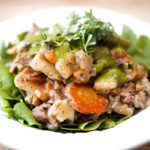THERE’S SOMETHING UNIQUELY COMFORTING ABOUT THE THICK TEXTURE AND RICH TASTE OF SOFT ROOT VEGETABLES IN GRAVY WITH A ROASTED BIRD.
This rich stew is a spin off of the pot pie, as matter of fact, you can use it as the filling for one. Or if you like you can also modify this gravy-like stew into a chunky brothy soup by adding more liquid. But I do recommend you give it a try just like this! It’s excellent over greens or grains like millet, buckwheat or amaranth.

COOKING NOTES
This recipe yields a batch of about 3 quarts, if this is too much for you, simply cut the recipe in half or freeze and store leftovers in single serve glass jars. Be sure to let the stew cool completely before freezing and only fill the jar 2/3 full to ensure enough room for expansion.
To quickly defrost, set the jar at room temperature for about 10 minutes, then place in a pot of warm (not hot) tap water. Replace the water with warmer water after about 5 minutes. Repeat if needed. Once enough of the outer layer has been softened to allow the contents to slide out into a pan, defrost the rest in a covered pan over medium-low heat.
If the prep time between roasting and cooking feels too long
Consider roasting the turkey leg the evening before you plan to cook the stew. Prep time for the turkey will be about 5 minutes. Once roasted, let cool, cover with a plate or lid and place in the fridge right in the pan. The next evening you’re looking at about 20 minutes prep and 30 minutes cooking time.
To substitute with chicken follow the same instructions. Roast for about 40 minutes.
Season the meat with your favorite herbs
I seasoned my turkey with rue and bay leaf, but a duo of any of the following would impart an aromatic flavor: rosemary, thyme, marjoram, oregano or sage.
IF YOU HAPPEN TO GET YOUR HANDS ON SOME RUE
This lesser known herb has both an interesting flavor and a long history in English culinary and European healing traditions. With its English roots, it adds just the right flavor to this stew meant for a pot pie. Rue on it’s own has an unusual flavor fragrant with a hint of cinnamon at first. As it makes its way down the back of your tongue it quickly becomes bitter and astringent. It should not be eaten on its own, but in moderation it infuses the slightly gamey turkey leg meat with a wonderful musky aroma.
Although you’ll find that Shakespeare mentions rue in relation to it’s healing and protective powers, Michelangelo and Leonardo Da Vinci routinely ate the herb in hopes of improving their eyesight and heightening creativity, modern herbalists don’t recommend consuming rue. Some people may have a reaction to the oils and develop a rash or stomach upset. Despite all this, rue continues to be used in Mediterranean dishes today in small amounts and I’ve seen it more frequently at Farmer’s Markets in recent years. I had no trouble with the small amount shown below, but do your research before seeking it out.
If you’re pregnant, this herb is not recommended.






